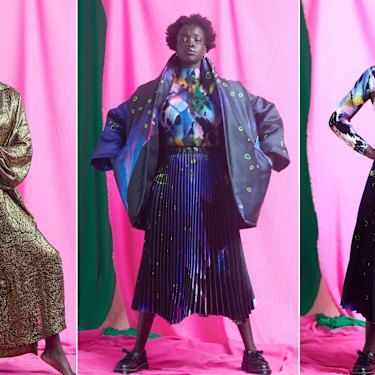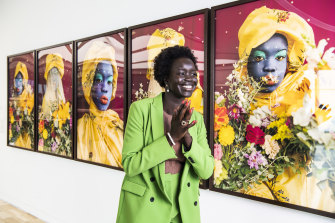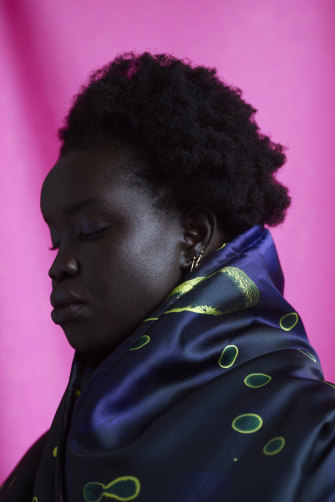By Damien Woolnough
Atong Atem is the inaugural winner of the Art Gallery of NSW’s La Prairie Art Award. Credit:Nic Walker
Enhancing our best features while concealing flaws is make-up’s primary purpose but artist Atong Atem wields lipsticks, face paints and mascara like wands, performing spellbinding transformations that go beyond the perfect pout. The results are arresting, beautiful and vastly different to the airbrushed images of blonde, blue-eyed models she was surrounded by as a kid in Gosford, on the NSW Central Coast.
“When I have a bright blue face with diamantés on it and hot pink lips with yellow outlines, people say ‘that’s so beautiful’,” says Atong, 30. “Growing up as a black kid on the Central Coast, that was the furthest thing from beauty.
“I’ve spent so much of my time in Australia with the understanding that I’m inherently alien, which is deeply ironic when you stop to think about colonisation. I grew up knowing that my features and appearance are something ‘other’ in white Australia.”
Atong’s self-portrait has been acquired by the Art Gallery of NSW.Credit:Louise Kennerley
Otherness was what Atong felt as a child, seeking people who shared her South Sudanese heritage in magazines and television programs that steadfastly ignored the country’s diversity. That otherness is now challenged by being the inaugural winner of the Art Gallery of NSW’s La Prairie Art Award, aimed at supporting Australian women artists.
Her prize, a partnership between the gallery and the Swiss skincare company, is a $50,000 acquisition and $30,000 worth of travel. As part of the award, Atong, who lives in Melbourne, will head to Switzerland in June to attend the influential Art Basel fair and take up a residency in Zurich.
Ask her whether her journey from outsider status to the centre of the art world has been strategic and the response is enthusiastic laughter, verging on guffaws. “I’m a seven-time university dropout,” she says. “That was seven successful and very expensive attempts at self-sabotage.”
Initially, Atong was attracted to a career as an academic, navigating art history from a perspective that shifted the spotlight from European masters to African painters and sculptors. But when her focus shifted to traditional oil painting, she swapped conventional brushes for foundation blenders.
“I was living in Newcastle with hippie friends, and they taught me the skill of face painting,” she says. “It became a fun way to practise it – oil paint is a lot more expensive than face paint.
“To this day, I find make-up quite challenging. My friends are always saying, ‘If you can do that with blue paint, surely you can do something with foundation.’ ”
For the acquisition, A Yellow Dress, a Bouquet – a self-portrait in five parts – Atong’s face is violet rather than blue, punctuated by garish turquoise eyelids and coral lips. In swathes of yellow fabric, her steely gaze meets the camera.
For the artist, the process of creation is just as important as the result now hanging on the art gallery’s walls. “It’s never like, ‘this is what I’m going to do’,” she says. “I will sit and see what will happen. When I’m making my work it’s so freeing.”
“It started as a reaction to the chaos of life. No matter what would happen in the day, I knew I could go home, sit in front of my mirror, put on some music, paint my face and take my time.”Credit:Nic Walker
She says that self-portraits and face painting tend to happen in the early morning, when she can’t sleep. “It started as a reaction to the chaos of life. No matter what would happen in the day, I knew I could go home, sit in front of my mirror, put on some music, paint my face and take my time.”
Atong acknowledges the influence of Malian photographers Malick Sidibé and Seydou Keita on her self-portraiture, but dive into her creations and you are immediately immersed in the chaotic terrain of today’s world and an imagined tomorrow.
It was through the instruments of today’s world, mainly the micro-blog platform Tumblr, that a teenage Atong first connected with the work of other artists. “It made me feel less alone,” she says. “I learnt about Afrofuturism, African and African-American philosophers, thinkers and artists in the 19th century.”
The imagined dimension came when she discovered the power of science fiction to explore her reality. “Science fiction is the overarching lens in my life,” she says. “It’s a beautiful lens to look at humanity and history in general. When you look at aliens in popular culture, they’re never subtle. If they are represented with a minimalist aesthetic, they’re the bad guys. It’s the ones who are a vibrant amalgamation of all human creatures that we are meant to sympathise with.”
“Science fiction is the overarching lens in my life. It’s a beautiful lens to look at humanity and history in general.”
Atong channels this amalgamation of everything via her make-up – it’s helped shape her self-perception as an artist. “I just love excess,” she says. “It represents honesty to me. In my work, I am quite literally showing the things that I like. I am open to display. Nothing is under my rug.
“I’ve come to realise that the reason it feels so instinctive is because I have such a great catalogue of references from the last 30 years … It might seem like it’s from my imagination, but it’s so intensely referential.
“One image references a ’70s sci-fi film, an episode of The Simpsons, an Instagram video I saw and a Vogue photo shoot from 2003 I remembered. It’s all kind of there, and it just becomes Atong.”
The conviction and authority with which she explains her work fails to convey her modesty – and those contagious guffaw-bordering laughs.
“I still am in that position of being an emerging artist and being quite under the radar, so I feel comfortably hidden but still have remarkable opportunities,” she says. “It would be a bit overwhelming to have more responsibility at this time. I am doing all of this myself. I want to stay at this emerging level for as long as I can.
“Sometimes, it almost feels like this could end at any time, which leads to me being jovial, happy and excited when I’m doing work.
“I spent plenty of time working in retail and hospitality, so for me it’s pretty incredible that I get to paint my face and talk about it.”
To read more from Sunday Life magazine, click here.
Make the most of your health, relationships, fitness and nutrition with our Live Well newsletter. Get it in your inbox every Monday.
Most Viewed in Lifestyle
Source: Read Full Article


